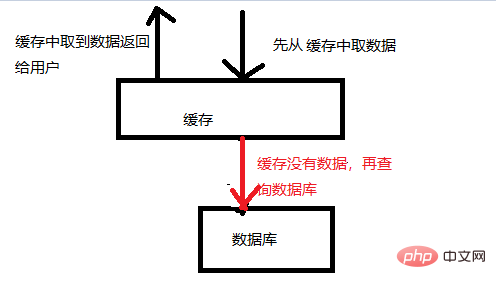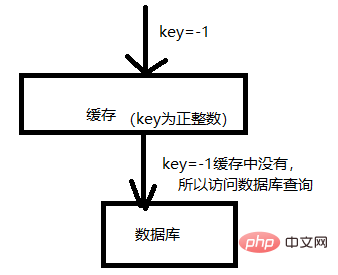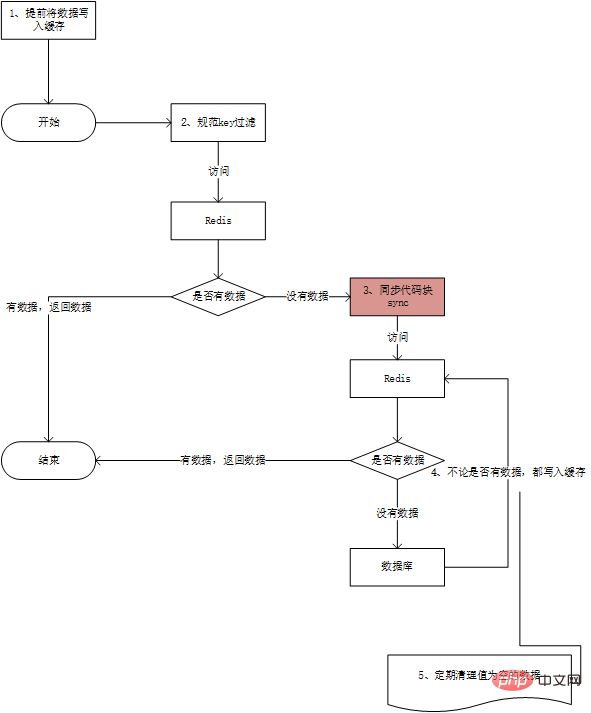How to solve redis cache penetration

Caching technology can be used to reduce the pressure on the database and improve access efficiency. Currently, caching is being paid more and more attention in enterprise projects. But caching doesn’t mean just adding projects casually. Integrating caching into the project is the first step. The penetration problem caused by the cache and the resulting snow bounce problem are all issues that we urgently need to solve. This article will share with you the solutions I use in my daily projects for your reference.
1. The principle of cache penetration
The normal use of cache is as shown in the figure:

As shown in the figure, the cache usage process :
1. First get the data from the cache. If it can be obtained, return the data directly to the user. This eliminates the need to access the database and reduces the pressure on the database.
2. If there is no data in the cache, the database will be accessed.
There will be a BUG here, as shown in the picture:

As shown in the picture, the cache is like a firewall for the database, which will request more frequently data. Put it in the cache to reduce the pressure on the database. But if someone attacks maliciously, they can easily penetrate your cache and put all the pressure on the database. For example, in the picture above, the keys in your cache are all positive integers, but I use negative numbers as keys to access your cache. This will cause the cache to be penetrated and put pressure directly on the database.
2. Reasons for cache penetration
The problem of cache penetration must be under no matter how large the concurrency is. Based on this premise, we analyze the reasons for cache penetration as follows:
1. Malicious attack, guess your key naming method, and then estimate to use a key that is not in your cache to access.
2. For the first data access, if there is no data in the cache yet, in a concurrent scenario, all requests will be pushed to the database.
3. The data in the database is also empty, so even if the database is accessed, the data cannot be obtained, so there must be no corresponding data in the cache. This can also lead to penetration.
3. Solving cache penetration
Cache penetration lies in avoiding the reasons for penetration step by step, as shown in the figure:

As shown above As shown, the solution steps are as follows:
1. When the web server starts, write data that may be frequently accessed concurrently into the cache in advance. —This avoids queuing and blocking of a large number of requests in step 3.
2. Standardize the naming of keys and unify cache query and write entries. In this way, at the entrance, the specification of the key is detected. – In this way, malicious keys are saved and intercepted.
-
3. Synchronized double detection mechanism. At this time, we need to use the synchronization (Synchronized) mechanism to check whether the corresponding key exists in the cache before the synchronization code block, and then synchronize the code block Check again whether the cache contains the key to be queried. The purpose of this "double detection" is to avoid meaningless database access caused by concurrent scenarios (it is also a solution that strictly avoids penetration).
This step will cause queuing, but as we said in the first step, in order to avoid a large number of queuing, a large number of predictable requests can be written to the cache in advance.
4. Regardless of whether there is data in the database, the corresponding key is saved in the cache. The value is empty. – This is to avoid ordinary cache-penetrating access to the database due to the absence of this data in the database.
5. If there are too many null values in step 4, it will also cause memory exhaustion. Causes unnecessary memory consumption. In this way, the keys with empty values must be cleaned regularly. Prevent the memory from being maliciously occupied. As a result, normal functions cannot cache data.
For more Redis-related technical articles, please visit the Redis Tutorial column to learn !
The above is the detailed content of How to solve redis cache penetration. For more information, please follow other related articles on the PHP Chinese website!

Hot AI Tools

Undresser.AI Undress
AI-powered app for creating realistic nude photos

AI Clothes Remover
Online AI tool for removing clothes from photos.

Undress AI Tool
Undress images for free

Clothoff.io
AI clothes remover

AI Hentai Generator
Generate AI Hentai for free.

Hot Article

Hot Tools

Notepad++7.3.1
Easy-to-use and free code editor

SublimeText3 Chinese version
Chinese version, very easy to use

Zend Studio 13.0.1
Powerful PHP integrated development environment

Dreamweaver CS6
Visual web development tools

SublimeText3 Mac version
God-level code editing software (SublimeText3)

Hot Topics
 1382
1382
 52
52
 How to build the redis cluster mode
Apr 10, 2025 pm 10:15 PM
How to build the redis cluster mode
Apr 10, 2025 pm 10:15 PM
Redis cluster mode deploys Redis instances to multiple servers through sharding, improving scalability and availability. The construction steps are as follows: Create odd Redis instances with different ports; Create 3 sentinel instances, monitor Redis instances and failover; configure sentinel configuration files, add monitoring Redis instance information and failover settings; configure Redis instance configuration files, enable cluster mode and specify the cluster information file path; create nodes.conf file, containing information of each Redis instance; start the cluster, execute the create command to create a cluster and specify the number of replicas; log in to the cluster to execute the CLUSTER INFO command to verify the cluster status; make
 How to clear redis data
Apr 10, 2025 pm 10:06 PM
How to clear redis data
Apr 10, 2025 pm 10:06 PM
How to clear Redis data: Use the FLUSHALL command to clear all key values. Use the FLUSHDB command to clear the key value of the currently selected database. Use SELECT to switch databases, and then use FLUSHDB to clear multiple databases. Use the DEL command to delete a specific key. Use the redis-cli tool to clear the data.
 How to use the redis command
Apr 10, 2025 pm 08:45 PM
How to use the redis command
Apr 10, 2025 pm 08:45 PM
Using the Redis directive requires the following steps: Open the Redis client. Enter the command (verb key value). Provides the required parameters (varies from instruction to instruction). Press Enter to execute the command. Redis returns a response indicating the result of the operation (usually OK or -ERR).
 How to use redis lock
Apr 10, 2025 pm 08:39 PM
How to use redis lock
Apr 10, 2025 pm 08:39 PM
Using Redis to lock operations requires obtaining the lock through the SETNX command, and then using the EXPIRE command to set the expiration time. The specific steps are: (1) Use the SETNX command to try to set a key-value pair; (2) Use the EXPIRE command to set the expiration time for the lock; (3) Use the DEL command to delete the lock when the lock is no longer needed.
 How to read redis queue
Apr 10, 2025 pm 10:12 PM
How to read redis queue
Apr 10, 2025 pm 10:12 PM
To read a queue from Redis, you need to get the queue name, read the elements using the LPOP command, and process the empty queue. The specific steps are as follows: Get the queue name: name it with the prefix of "queue:" such as "queue:my-queue". Use the LPOP command: Eject the element from the head of the queue and return its value, such as LPOP queue:my-queue. Processing empty queues: If the queue is empty, LPOP returns nil, and you can check whether the queue exists before reading the element.
 How to implement the underlying redis
Apr 10, 2025 pm 07:21 PM
How to implement the underlying redis
Apr 10, 2025 pm 07:21 PM
Redis uses hash tables to store data and supports data structures such as strings, lists, hash tables, collections and ordered collections. Redis persists data through snapshots (RDB) and append write-only (AOF) mechanisms. Redis uses master-slave replication to improve data availability. Redis uses a single-threaded event loop to handle connections and commands to ensure data atomicity and consistency. Redis sets the expiration time for the key and uses the lazy delete mechanism to delete the expiration key.
 How to read the source code of redis
Apr 10, 2025 pm 08:27 PM
How to read the source code of redis
Apr 10, 2025 pm 08:27 PM
The best way to understand Redis source code is to go step by step: get familiar with the basics of Redis. Select a specific module or function as the starting point. Start with the entry point of the module or function and view the code line by line. View the code through the function call chain. Be familiar with the underlying data structures used by Redis. Identify the algorithm used by Redis.
 How to make message middleware for redis
Apr 10, 2025 pm 07:51 PM
How to make message middleware for redis
Apr 10, 2025 pm 07:51 PM
Redis, as a message middleware, supports production-consumption models, can persist messages and ensure reliable delivery. Using Redis as the message middleware enables low latency, reliable and scalable messaging.




